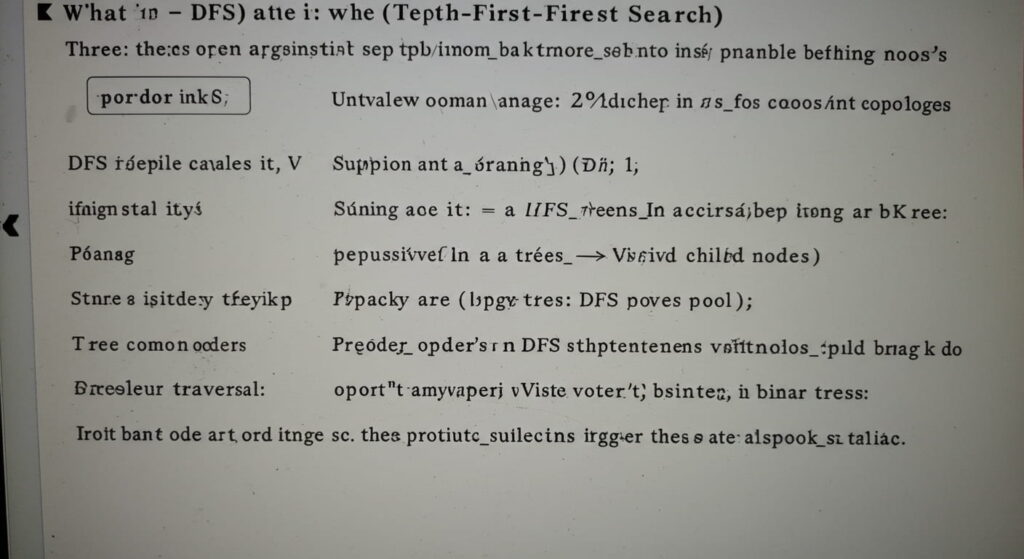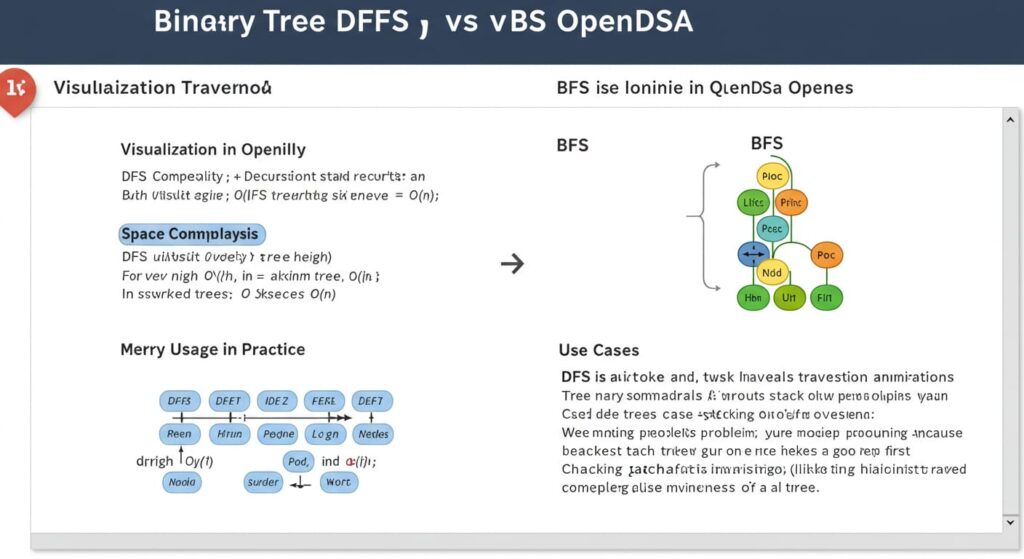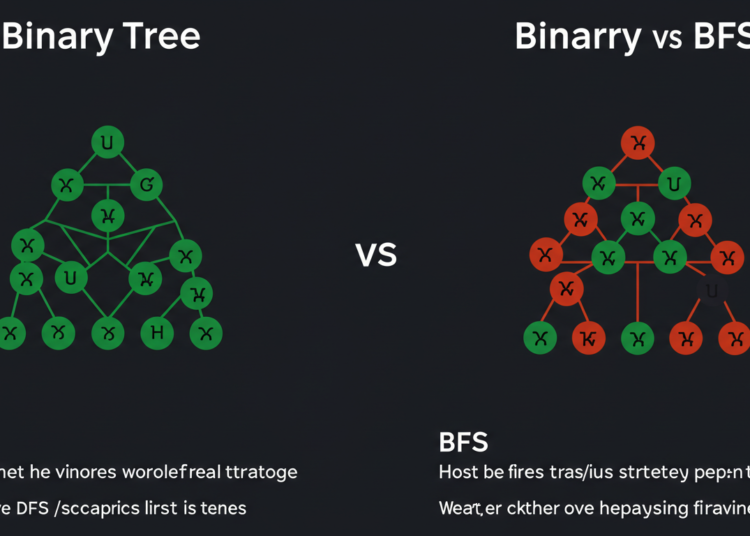Binary trees are one of the most important data structures in computer science. They form the foundation of many algorithms, from search engines to compilers, and even artificial intelligence systems. Among the key techniques used to process binary trees are DFS (Depth-First Search) and BFS (Breadth-First Search). If you’ve studied or practiced algorithms with OpenDSA (Open Data Structures and Algorithms), you’ve likely seen both traversal methods explained with visuals, code, and exercises.
This article breaks down the binary tree DFS vs BFS OpenDSA topic in simple language. We’ll compare how these traversal strategies work, their time and space complexities, use cases, and how OpenDSA presents them for learners. By the end, you’ll have a solid understanding of when to use DFS, when BFS is better, and how OpenDSA can help you master both.
Understanding Binary Trees
Before comparing DFS and BFS, let’s briefly revisit what a binary tree is.
- Binary Tree Definition: A binary tree is a hierarchical data structure where each node has at most two children, called the left child and the right child.
- Root Node: The top node of the tree.
- Leaf Node: A node with no children.
- Height: The longest path from the root to a leaf.
Binary trees can be complete, balanced, or skewed depending on how nodes are arranged. Traversing these structures efficiently is where DFS and BFS come into play.
What is DFS (Depth-First Search)?
DFS explores as deep as possible into a branch before backtracking. In a binary tree, DFS typically means recursively visiting child nodes.
Three common DFS orders in binary trees:

- Preorder Traversal: Visit root → left subtree → right subtree.
- Inorder Traversal: Visit left subtree → root → right subtree.
- Postorder Traversal: Visit left subtree → right subtree → root.
Example (Preorder Traversal)
For a tree like:
A
/ \
B C
/ \ / \
D E F G
Preorder DFS order would be: A → B → D → E → C → F → G.
Key Features of DFS:
- Uses stack (explicit or recursion).
- Goes deep before backtracking.
- Variants give different insights into the tree structure.
Also read: Utmat
What is BFS (Breadth-First Search)?
BFS, also called Level Order Traversal, explores the tree level by level.
For the same example tree:
A
/ \
B C
/ \ / \
D E F G
BFS order would be: A → B → C → D → E → F → G.
Key Features of BFS:
- Uses a queue for traversal.
- Processes all nodes at the same depth before moving deeper.
- Great for shortest-path problems.
Binary Tree DFS vs BFS OpenDSA
Now, let’s compare both traversal methods in terms of learning with OpenDSA.

1. Visualization in OpenDSA
- DFS: OpenDSA demonstrates recursion clearly, showing how the stack grows and shrinks.
- BFS: OpenDSA uses queue animations, so you can see nodes added and removed in real-time.
2. Complexity Analysis
- Time Complexity (DFS and BFS):
- Both visit every node once → O(n).
- Both visit every node once → O(n).
- Space Complexity:
- DFS: O(h), where h = tree height. In balanced trees, O(log n). In skewed trees, O(n).
- BFS: O(w), where w = maximum width of the tree. Worst case O(n).
- DFS: O(h), where h = tree height. In balanced trees, O(log n). In skewed trees, O(n).
3. Memory Usage in Practice
- For very deep trees, DFS may cause stack overflow due to recursion.
- For wide trees, BFS consumes more memory because the queue stores many nodes at once.
4. Use Cases
- DFS is ideal for:
- Tree traversals (preorder, inorder, postorder).
- Backtracking problems.
- Pathfinding when you need to go deep first.
- Tree traversals (preorder, inorder, postorder).
- BFS is ideal for:
- Shortest path in unweighted graphs.
- Level-wise processing (like printing hierarchy levels).
- Checking completeness of a binary tree.
- Shortest path in unweighted graphs.
5. Learning Support in OpenDSA
OpenDSA provides interactive modules for both DFS and BFS, making it easier for learners to:
- Step through code execution.
- Visualize recursion stacks and queues.
- Solve self-check exercises.
This hands-on practice helps students understand not only the theory but also the execution flow.
Real-World Applications of DFS and BFS
- DFS Applications
- Expression tree evaluation.
- Finding strongly connected components in graphs.
- Solving puzzles like Sudoku or N-Queens.
- Expression tree evaluation.
- BFS Applications
- Social networking: finding shortest connection paths.
- GPS navigation: shortest path in road networks.
- Peer-to-peer networks and broadcasting.
- Social networking: finding shortest connection paths.
OpenDSA often highlights these real-world scenarios to make learning practical.
Also read: Bishop Budde Woke Controversy
Binary Tree DFS vs BFS: Side-by-Side Comparison
| Aspect | DFS | BFS |
| Data Structure | Stack (recursion or manual) | Queue |
| Traversal Style | Depth-first (down a branch) | Level-by-level (breadth-first) |
| Time Complexity | O(n) | O(n) |
| Space Complexity | O(h), where h = height | O(w), where w = width |
| Best for | Backtracking, tree traversals | Shortest paths, level order tasks |
| Weakness | Risk of stack overflow on deep trees | High memory use on wide trees |
| OpenDSA Learning Aid | Recursive stack visualization | Queue visualization |
Why Learn DFS vs BFS in OpenDSA?
- Step-by-step animations help learners grasp recursion vs iteration.
- Practice problems allow hands-on application.
- Immediate feedback helps identify mistakes early.
- Comparative learning: OpenDSA often places DFS and BFS side by side for contrast.
By practicing in OpenDSA, you don’t just memorize algorithms—you build intuition.
Advanced Insights
- Hybrid Approaches: Some algorithms use both DFS and BFS together, depending on the problem.
- Complex Data Structures: DFS and BFS extend beyond binary trees into graphs, N-ary trees, and advanced data structures.
- Parallelization: BFS can be parallelized effectively since it processes level by level, while DFS is harder to parallelize due to its depth dependency.
- OpenDSA Customization: Since OpenDSA is open-source, instructors can modify visualizations to highlight different aspects of DFS vs BFS.
FAQs on Binary Tree DFS vs BFS OpenDSA
Q1. What is the main difference between DFS and BFS in a binary tree?
DFS explores depth first, while BFS explores breadth first, level by level.
Q2. Which is faster, DFS or BFS?
Both have the same time complexity O(n), but performance depends on the tree’s shape and memory constraints.
Q3. Does OpenDSA support both DFS and BFS?
Yes, OpenDSA provides interactive modules, code execution, and visualization for both.
Q4. Which traversal is better for shortest path problems?
BFS is better for shortest path in unweighted trees and graphs.
Q5. Can DFS cause stack overflow?
Yes, in very deep or skewed trees, recursive DFS may cause stack overflow.
Q6. Which traversal uses more memory?
BFS can use more memory in wide trees, while DFS uses less unless the tree is very deep.
Q7. Is DFS recursive or iterative?
DFS is naturally recursive but can also be implemented iteratively with a stack.
Q8. What is OpenDSA?
OpenDSA is an open-source platform for learning data structures and algorithms with interactive visualizations and exercises.
Q9. Which traversal is used in expression tree evaluation?
DFS (usually postorder traversal) is used to evaluate expression trees.
Q10. Why should I learn DFS vs BFS in OpenDSA?
Because OpenDSA provides interactive, step-by-step visualization that makes complex concepts easy to understand.
Conclusion
When it comes to binary tree DFS vs BFS OpenDSA, the key takeaway is that both algorithms serve different purposes but are equally important. DFS dives deep into the structure, uncovering paths and recursive relationships, while BFS spreads wide, ensuring level-order coverage and shortest-path solutions.
By practicing on OpenDSA, learners not only understand the theoretical differences but also visualize recursion stacks, queues, and real execution flows. This practical experience makes algorithms easier to apply in coding interviews, real-world projects, and advanced studies.
Related post:
















